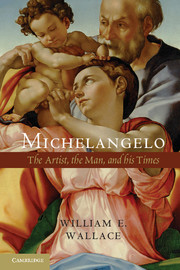Book contents
- Frontmatter
- Contents
- Preface
- Note to the Reader
- Michelangelo - The Artist, the Man and His Times
- PART I
- Introduction
- 1 ROME, 1496
- 2 ARISTOCRAT OF ARTISTS
- 3 RISE TO PROMINENCE
- 4 PAPAL SUMMONS
- 5 ROME, 1508–1516
- 6 FLORENCE, 1515–1525
- 7 A WEEK IN THE LIFE
- 8 FLORENCE, 1525–1534
- PART II
- Notes
- Cast of Principal Characters
- Popes During Michelangelo's Life
- Abbreviations of Frequently Cited Works
- Index
- Plate section
4 - PAPAL SUMMONS
Published online by Cambridge University Press: 05 June 2012
- Frontmatter
- Contents
- Preface
- Note to the Reader
- Michelangelo - The Artist, the Man and His Times
- PART I
- Introduction
- 1 ROME, 1496
- 2 ARISTOCRAT OF ARTISTS
- 3 RISE TO PROMINENCE
- 4 PAPAL SUMMONS
- 5 ROME, 1508–1516
- 6 FLORENCE, 1515–1525
- 7 A WEEK IN THE LIFE
- 8 FLORENCE, 1525–1534
- PART II
- Notes
- Cast of Principal Characters
- Popes During Michelangelo's Life
- Abbreviations of Frequently Cited Works
- Index
- Plate section
Summary
In late February 1505, Michelangelo received a summons from Rome along with a hefty 100-ducat advance.1 Florentine friends – Giuliano da Sangallo and the banker Alamanno Salviati – had recommended the artist to Pope Julius II. Although jeopardizing his numerous Florentine commissions – most notably the Twelve Apostles and the Battle of Cascina – this was not an opportunity to miss.
It was cold and drizzling when Michelangelo left Florence in early March. The ride to Rome was long and unpleasant, but the self-confident artist was buoyed by anticipation. Rome seemed little changed in the four years since Michelangelo last saw the city, except around the Vatican where the architect Donato Bramante had begun a huge project connecting the Belvedere villa to St. Peter's. The election of the energetic Pope Julius II in 1503, following the corrupt regime of Alexander VI and the short-lived reign of Pius III, began an era of a resurgent, newly respected papacy. It appeared that Julius had ambitions of once again making Rome an imperial city.
During the next few weeks, Michelangelo was “continuously” at the house of his friend, the elderly papal architect Giuliano da Sangallo. Giuliano, whom Michelangelo had first met in the Medici household, was thirty years older than his protégé. He was an accomplished architect and engineer who recently had designed the hoist– and–rolling cart mechanism to move the David from the Florentine cathedral to Piazza della Signoria. He was a kindly and genial man with broad, open features and thin, straggly hair.
- Type
- Chapter
- Information
- MichelangeloThe Artist, the Man and his Times, pp. 72 - 88Publisher: Cambridge University PressPrint publication year: 2009

